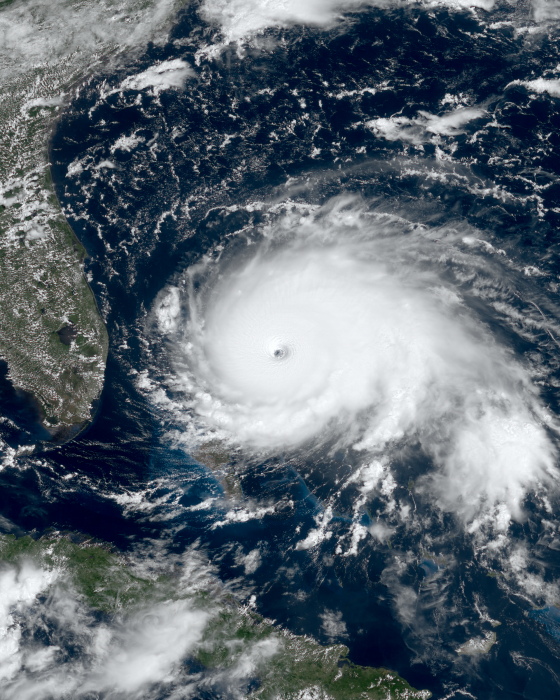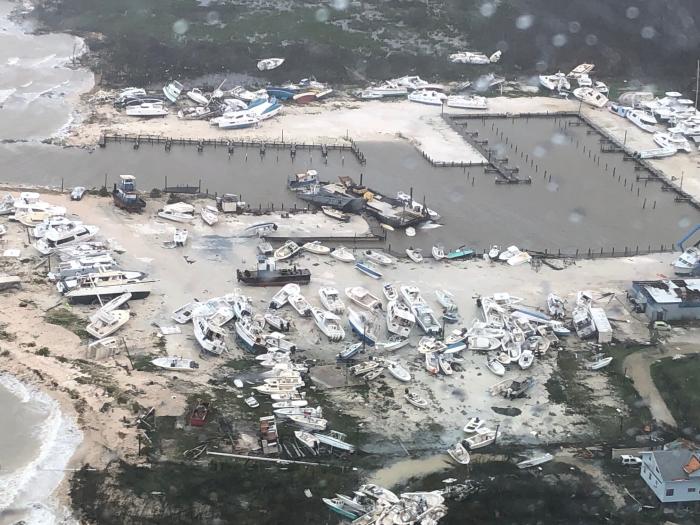Hurricane Dorian: September 2019
The Bahamas are used to hurricanes. There is no official “hurricane alley” (like tornado alley) but if there were, the Bahamas would be smack in the middle of it. The island nation is generally under a hurricane watch and warning several times a year and has been ravaged by storms in the past. But nothing like Dorian. The storm moved through the Caribbean and took aim on the islands before rapidly strengthening as it approached. Dorian made landfall on September 1, 2019, on Grand Abaco Island with sustained winds of 185 mph and gusts over 220 mph, let me repeat that sustained winds of 185 mph and gusts over 220 mph (!), making it one of the strongest storms on record in the Atlantic and Pacific.


Dorian was an unusual storm in several ways. Remember in the last module we learned that hurricane strength is generally measured by the minimum atmospheric pressure, and Dorian’s pressure was not that low. But, the storm was enormous. Dorian was particularly deadly because the devastating winds were combined with an extremely slow forward motion of about 5 mph so that the storm ravaged the Bahamas for days. Devastating storms like Andrew and Katrina had much faster motion, but the slow speed of Dorian made the damage much, much worse. It’s hard to imagine what it would have been like for all the citizens of the Bahamas to have experienced the impacts of the storm for that long. After pummeling the Abacos, a group of islands in the northeast Bahamas, the storm went back over open water and made landfall without weakening on September 2 on Grand Bahama, the largest Bahama island, where it literally stalled for a day before weakening a little and moving back over open water. The damage to the Bahamas was truly catastrophic, as the pictures show.
The Bahamas had plenty of time to prepare for Dorian. Evacuation orders for low-lying areas were given the day before the storm and residents were urged to seek shelter on higher ground, boats picked people up from small, low-lying islands, and resorts were closed, but even so, many people ignored the warnings. At landfall on the Abacos and again on Grand Bahama, Dorian’s intense winds were accompanied by a massive storm surge of about 6-9 meters (20-25 feet) and heavy rain. In total, about a meter (3 feet) of rain fell over most of the northern Bahamas. Again, imagine experiencing these winds, rains, and storm surge for almost a whole day like folks in the Abacos and Grand Bahama did! It must have been truly terrifying on both sets of islands. There are harrowing tales of people clinging on to trees and other harrowing survival stories, but sadly many were not so fortunate. The official death toll from Dorian is 70, but is almost certainly much, much higher because there were many undocumented citizens living in shantytowns. Initially, there were over 1000 people missing, and now that number is around 300, so the death toll is likely to be 500-600. The true number may never be known.
Watch these short videos that show incredible footage of the peak of the storm and its aftermath!
Video: Hurricane Dorian batters Bahamas with severe flash floods and ferocious wind (1:48)
Text on screen: Hurricane Dorian has brought chaos and disruption to the Bahamas.
Voices yelling: Swim! Swim! Swim! Swim! Keep going!
Man: Alright, we gotta move, guys. We have to jump a fence over here.
Text on screen: One of the most powerful Atlantic hurricanes on record brought ferocious wind and heavy flash floods, damaging over 13,000 homes.
Man: I'm on top of the sink right now.
Man: That's the water hitting my front room window, which is extremely high. And this is the water by my back door and glass. So this is what I'm facing at the moment.
Text on screen: The Rand Memorial Hospital in Freeport was also flooded and Freeport International Airport was 6 ft underwater. Dorian began its destructive path in the Abaco Islands where it killed at least five people and caused widespread damage. It then stalled over the Grand Bahama Island for over a day. Dorian is now crawling from the Bahamas towards the U.S.
Iram Lewis: We don't mind the properties, we just hope that lives will be saved. But as you can tell, we are going to need a lot of support after this hurricane is over.
Video: The town forgotten in the aftermath of Hurricane Dorian (4:33)
Stuart Ramsay, Reporter: This disaster remains an emergency, and even now it's growing in different ways. On Grand Bahama, an oil storage facility next to pristine waters is spewing oil into the environment. The hurricane winds literally tore off the lids of these huge tanks. Oil is clearly using out of one of the stores. The land around the facility is saturated in oil. One of the tanks appears to have emptied itself. With so much damage to the island's infrastructure and so much human need, nobody's been able to deal with this yet. And the human crisis remains a serious problem. Roads and bridges linking isolated communities are still unpassable. On Abaco island, the community of Fox Town is only just getting aid. The houses here were overwhelmed by the storm surge. People here are still waiting in lines hoping to be evacuated. It's happening, but the process is long and there are so many others in need as well. While they may have made it on board, this is another family split by this storm. And thousands upon thousands of people here are homeless, and many have still not been able to get to safety. This village, once home to 2,000 people, doesn't have a name. Now it doesn't exist either, completely leveled by Dorian. But as we circled we saw signs of life - washing on clotheslines, then a glimpse of people beneath us. We landed and took them what food and water we had and to see how they were. These are the Haitian workers of a long since closed farm. They took us into what was the center of the village. How anyone survived here is quite remarkable. It has been obliterated. Most of the survivors fled in the aftermath of the storm, leaving this small group behind. They're cut off. They have no communication or vehicles. Nobody knew they were here, forgotten in the chaos.
Stuart Ramsay interviewing a survivor. So people came out of the house...
Survivor Newman Jean: Yeah.
Stuart: ...to try to get to another house and then it got blown down too.
Newman Jean: It blew down, yes, it blew down.
Stuart: But the storm lasted a long, long time.
Newman Jean: long time - he go, he come back, he go, he come back, that's it
Stuart: What happened here was horrendous. The emotional toll it's taken on the survivors is difficult to imagine. Everything for them must seem hopeless now. And however strong they appear, they're hurting. None of these survivors have been able to speak to their family since the storm. They used our satellite phones and the first contact is hard too.
The roof of Mark San Vincent's home was torn off in seconds.
Stuart interviewing Mark San Vincent: Have you put this back on?
Mark San Vincent: Yes, sir.
Stuart: So the whole roof?
Mark San Vincent: Yes, sir.
Stuart: So under the car here?
Mark San Vincent: Under the car, yeah.
Stuart: And you survived in there?
Mark San Vincent: yeah
Stuart: Holding his wife and baby, they made it outside and hid beneath the car. Incredibly they survived. What happens next, he has no idea.
Mark San Vincent: I got my wife on Nassau yesterday. I got baby to Nassau yesterday. I'm just gonna stay for a couple of weeks, but I don't know. I got no money to go to Nassau. I just sleep on the outside.
Stuart: How families have been torn apart by Hurricane Dorian, none will ever forget this. But perhaps the youngest are the most resilient.
Young boy: The storm was like wind, raining, and water.
Stuart: Were you scared?
Young boy: Yes sir.
Stuart: This battered group in this destroyed community is representative of so many thousands of people who endured the storm and are now struggling with the survival. Like the islands themselves, the people will take years to recover.
Stuart: Stuart Ramsay, Sky News in the Bahamas.
On the Abacos, 60 percent of homes were destroyed, in total thousands of homes, including most of the poor shanty town dwellings. The power grid was completely destroyed and the airport flooded. 60% of Grand Bahama island was left underwater, hundreds of homes destroyed and a hospital was badly contaminated by sewage. Dorian will certainly be remembered as one of the most devastating Atlantic storms.
Hurricane Dorian
Moving forward, the lesson from Dorian, like Harvey, is definitely that our warming climate often results in storms that move super slowly. We need to prepare for a Dorian-like storm to hit Miami or New Orleans or under the right circumstances, even Washington DC. Building codes and infrastructure need to be adapted for this eventuality. It’s just a matter of time.
